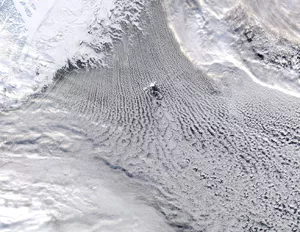Retreating sea ice linked to ocean circulation, European climate change : UTM study

Retreating sea ice in the Iceland and Greenland Seas may be changing the circulation of warm and cold water in the Atlantic Ocean, and could ultimately impact the climate in Europe, says a new study by an atmospheric physicist from the University of Toronto Mississauga (UTM) and his colleagues in Great Britain, Norway and the United States.
“A warm western Europe requires a cold North Atlantic Ocean, and the warming that the North Atlantic is now experiencing has the potential to result in a cooling over western Europe,” says Professor G.W.K. Moore of UTM’s Department of Chemical & Physical Sciences.
As global warming affects the earth and ocean, the retreat of the sea ice means there won’t be as much cold, dense water, generated through a process known as oceanic convection, created to flow south and feed the Gulf Stream. If convection decreases, says Moore, the Gulf Stream may weaken, thereby reducing the warming of the atmosphere, in comparison to today.
Their research, published in Nature Climate Change on June 29, is the first attempt to examine and document these changes in the air-sea heat exchange in the region -- brought about by global warming -- and to consider its possible impact on oceanic circulation, including the climatologically important Atlantic Meridional Overturning Circulation.
Previous studies have focused instead on the changing salinity of the northern seas and its effects on ocean circulation.
Moore and his fellow researchers based their findings on wintertime data from 1958 to 2014 that was provided by the European Centre for Medium-Range Weather Forecasts and model simulations.
Traditionally, the Gulf Stream moves warm water north toward western Europe, says Moore, where it loses heat and moisture to the atmosphere, acting to moderate the climate in this region. The resulting colder, denser water sinks and returns south at a great depth eventually rising to the surface in the tropics, where the cycle, known as the Atlantic Meridional Ocean Circulation, begins all over again.
The Iceland and Greenland Seas are among the only places worldwide where conditions are right and this heat exchange is able to change the ocean’s density enough to cause the surface waters to sink. The largest air-sea heat exchange in these seas occurs at the edge of the sea ice.
In the past, this region of maximum heat exchange has coincided with the location where oceanic conditions are optimal for convection to occur. However, in recent years, the sea ice has retreated and with it the region of maximum heat exchange. As a result, there has been a reduction in the heat exchange over the locations where sinking occurs in the ocean. This has the potential to weaken oceanic convection in the Greenland and Iceland Seas.
“The heat exchange is weaker--it’s like turning the stove down 20 per cent,” says Moore. “We believe the weakening will continue and eventually cause changes in the Atlantic Meridional Overturning Circulation and the Gulf Stream, which can impact the climate of Europe.”
The paper’s other authors are Kjetil Vǻge from the University of Bergen, Robert Pickart from Woods Hole Oceanographic Institution and Ian Renfrew from the University of East Anglia.
MEDIA CONTACTS:
Professor G.W.K. Moore
Department of Chemical & Physical Sciences
University of Toronto Mississauga
905-828-5368
gwk.moore@utoronto.ca
Nicolle Wahl
U of T Mississauga Communications
905-569-4656
nicolle.wahl@utoronto.ca



